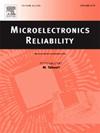基于铜柱凸点的微型led键合热-力耦合分析
IF 1.9
4区 工程技术
Q3 ENGINEERING, ELECTRICAL & ELECTRONIC
引用次数: 0
摘要
随着汽车电子和近眼显示技术的快速发展,对Micro-LED的异构集成技术提出了更严格的要求,特别是在互连结构方面。铜柱凸点具有更好的导电性、导热性和力学性能,可以满足Micro-LED阵列应用中更高密度、更小间距的封装要求。铜柱凸点在小间距互连结构中的应用已经有很多研究讨论,而铜柱凸点在微型led互连中的应用目前还很少见。本文提出了一种结合子模型技术的等效模型仿真方法。研究了等效方法的可行性和准确性。采用等效法对基于铜柱凸点的微型led键合过程进行了仿真。在上键合界面分别施加低温(40℃)和高温(280℃),研究键合温度对器件应力的影响。通过微型led键合实验验证了键合仿真的结果。本文章由计算机程序翻译,如有差异,请以英文原文为准。
Thermal-mechanical coupling analysis of Micro-LED bonding based on copper pillar bump
With the rapid development of automotive electronics and near-eye display, more stringent requirements are put forward for the heterogeneous integration technology of Micro-LED, especially in interconnect structure. The copper pillar bumps with better electrical conductivity, thermal conductivity and mechanical properties can meet the packaging requirements of higher density and smaller pitch for application of Micro-LED array. The application of copper bumps in small pitch interconnect structures have been discussed in many studies while the application of copper pillar bumps in Micro-LED interconnection is currently rare. An equivalent model method of simulation combined with sub-model technique is proposed in this paper. The feasibility and accuracy of the equivalent method was investigated. Simulation of Micro-LED bonding process based on copper pillar bumps with equivalent method was performed. Low-temperature (40 °C) and high-temperature (280 °C) were applied to the upper bonding interface respectively to investigate the influence of bonding temperature on the stress of the device. Micro-LED bonding experiment was performed to validate the results of bonding simulation.
求助全文
通过发布文献求助,成功后即可免费获取论文全文。
去求助
来源期刊

Microelectronics Reliability
工程技术-工程:电子与电气
CiteScore
3.30
自引率
12.50%
发文量
342
审稿时长
68 days
期刊介绍:
Microelectronics Reliability, is dedicated to disseminating the latest research results and related information on the reliability of microelectronic devices, circuits and systems, from materials, process and manufacturing, to design, testing and operation. The coverage of the journal includes the following topics: measurement, understanding and analysis; evaluation and prediction; modelling and simulation; methodologies and mitigation. Papers which combine reliability with other important areas of microelectronics engineering, such as design, fabrication, integration, testing, and field operation will also be welcome, and practical papers reporting case studies in the field and specific application domains are particularly encouraged.
Most accepted papers will be published as Research Papers, describing significant advances and completed work. Papers reviewing important developing topics of general interest may be accepted for publication as Review Papers. Urgent communications of a more preliminary nature and short reports on completed practical work of current interest may be considered for publication as Research Notes. All contributions are subject to peer review by leading experts in the field.
 求助内容:
求助内容: 应助结果提醒方式:
应助结果提醒方式:


